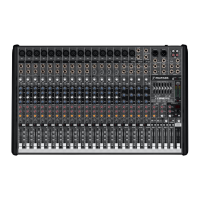
Do you have a question about the Mackie PROFESSIONAL MIC/LINE MIXERS WITH FX AND USB I/O PROFX16 and is the answer not in the manual?
| Channels | 16 |
|---|---|
| Line Inputs | 16 |
| Aux Sends | 4 |
| Subgroups | 4 |
| USB I/O | Yes |
| Phantom Power | Yes |
| Headphone Output | Yes |
| EQ Bands | 3-band |
| Main Outputs | XLR and 1/4" TRS |
Essential guidelines for safe operation, handling, and environment of the mixer.
Information on FCC/Canadian compliance and safe noise level exposure limits for hearing protection.
Steps to set up and connect the mixer, including zeroing controls and basic wiring.
Procedure for setting input gain and achieving basic mix levels for immediate sound.
Overview of USB features and essential operational tips for initial use.
Highlights of the mixer's capabilities, including FX, compressors, and USB.
Detailed explanation of the mixer's 2x2 USB interface for recording and playback.
Detailed list of all hardware and software features of the ProFX series mixers.
Explanation of the manual's organization, section breakdown, and special icons.
Diagram illustrating a common live sound system configuration using the mixer.
Details on connecting the power cord and the function of the power switch.
Explanation of the rear panel USB port for audio streaming and computer connection.
Details on XLR mic inputs, wiring, and the 48V phantom power activation.
Explanation of 1/4" line inputs, including balanced/unbalanced connections and hybrid channels.
Using insert jacks, adjusting gain, and applying the low cut filter.
Understanding EQ bands, setting monitor mixes, and controlling channel signal levels.
Controlling FX sends, panning, overload, muting, and channel routing.
Using PFL/Solo, adjusting channel faders, and assigning USB signals.
Explanation of the compressor's function, threshold adjustment, and dynamic range control.
Details on MON SEND and FX SEND outputs for stage monitors and external effects.
Connecting footswitches, using aux returns, and understanding main XLR/1/4" outputs.
Connecting control room monitors, headphones, and tape devices via RCA connections.
Explanation of the 48V phantom power switch and the mixer's power indicator.
How to use the 7-band graphic equalizer for main mix or monitor output adjustments.
Switching EQ for main mix/monitors and bypassing the graphic EQ.
Understanding main level meters and the RUDE SOLO LED indicator.
Controlling overall levels for aux monitor and FX sends, and adjusting aux return signals.
Using the built-in RMFX processor, selecting presets, and routing effects.
Configuring USB output for recording and selecting 2-track return sources (Tape/USB).
Using the break switch for muting, and adjusting control room/headphone levels.
Assigning channels to subgroups and controlling subgroup levels with faders.
Adjusting the main stereo mix level for outputs and audience.
Guidance for diagnosing and resolving common problems with channels and outputs.
Checking power status and procedures for obtaining warranty or non-warranty repair service.
Detailed descriptions of XLR, TRS, and TS phone connectors and their wiring.
Information on RCA connectors, their usage, and important notes on speaker cables.
How to use insert jacks for effects loops and send-only connections.
Technical data on noise characteristics, distortion levels, and input/output impedance.
Specifications for AC power requirements, physical dimensions, and product weight.
Diagrams illustrating the physical size and measurements of both mixer models.
Visual representation of the mixer's internal signal paths and component relationships.
Visual reference of all controls and connections for each mono channel strip.
Visual reference for compressor controls and all stereo channel strip components.
Visual reference of all master controls, EQ, effects, and output faders.
Detailed list of all 16 RMFX™ presets with descriptions and recommended applications.
Details on product warranty coverage, terms, conditions, and customer support contact.
